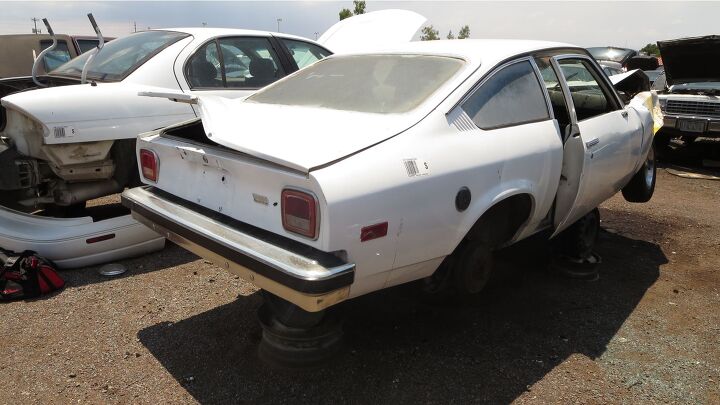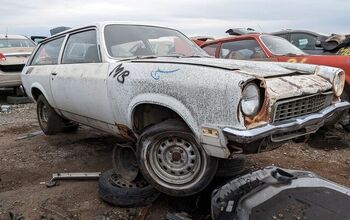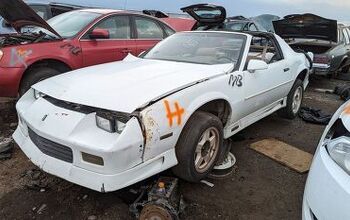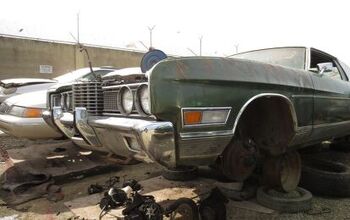Junkyard Find: 1972 Chevrolet Vega Hatchback Coupe

The General made more than two million Chevrolet Vegas during the car’s 1971-1977 run, and the numbers climb much higher if you include the Vega-derived Chevy Monza and its siblings. The Vega’s many quality problems and rapid cheap-subcompact depreciation led to nearly all of these cars disappearing from American roads well before the dawn of the 1990s, but I still find the occasional example during my junkyard travels. Here’s an early Vega two-door hatch that seemed to be in pretty good shape before it hit a large animal on an Arizona road a couple of years back.
Ouch. Let’s hope the driver was wearing the Vega’s modern (for 1972) shoulder belt correctly when the deer, cow, horse, or giant mutated javelina leaped in front of the car.
Most of the early Vegas came with four-speed manual transmissions, for the sake of cheapness and fuel economy, but the original purchaser of this car went for the automatic transmission option. Air conditioning would have been considered frivolous in a subcompact in 1972… unless you lived in Arizona, where AC-equipped white cars have been everywhere for decades. The radio is aftermarket, but I’m guessing this car once had at least the factory AM/FM unit.
No rust at all, which isn’t surprising, and we can assume that the powertrain was working at the time of the crash. Some lucky Arizona Vega lover may have harvested plenty of good parts off this car. Ninety horsepower when new, which would have felt like about 50 horses with that 3-speed automatic.
The Vega could have been the car that rendered Toyota, Honda, and Volkswagen irrelevant in North America during the 1970s, but it never lived up to the potential of its design. The same could be said of the Citation in the 1980s. Still, both the Vega and the Citation sold in large numbers, for a while, and I still look for them in wrecking yards.
Vegas are happy cars. They enjoy their work. They enjoy being driven.
If you like these junkyard posts, you can reach all 1,650+ right here at the Junkyard Home of the Murilee Martin Lifestyle Brand!

Murilee Martin is the pen name of Phil Greden, a writer who has lived in Minnesota, California, Georgia and (now) Colorado. He has toiled at copywriting, technical writing, junkmail writing, fiction writing and now automotive writing. He has owned many terrible vehicles and some good ones. He spends a great deal of time in self-service junkyards. These days, he writes for publications including Autoweek, Autoblog, Hagerty, The Truth About Cars and Capital One.
More by Murilee Martin
Latest Car Reviews
Read moreLatest Product Reviews
Read moreRecent Comments
- UnoGeeks Great information. Unogeeks is the top SAP ABAP Training Institute, which provides the best SAP ABAP Training
- ToolGuy This thing here is interesting.For example, I can select "Historical" and "EV stock" and "Cars" and "USA" and see how many BEVs and PHEVs were on U.S. roads from 2010 to 2023."EV stock share" is also interesting. Or perhaps you prefer "EV sales share".If you are in the U.S., whatever you do, do not select "World" in the 'Region' dropdown. It might blow your small insular mind. 😉
- ToolGuy This podcast was pretty interesting. I listened to it this morning, and now I am commenting. Listened to the podcast, now commenting on the podcast. See how this works? LOL.
- VoGhost If you want this to succeed, enlarge the battery and make the vehicle in Spartanburg so you buyers get the $7,500 discount.
- Jeff Look at the the 65 and 66 Pontiacs some of the most beautiful and well made Pontiacs. 66 Olds Toronado and 67 Cadillac Eldorado were beautiful as well. Mercury had some really nice looking cars during the 60s as well. The 69 thru 72 Grand Prix were nice along with the first generation of Monte Carlo 70 thru 72. Midsize GM cars were nice as well.The 69s were still good but the cheapening started in 68. Even the 70s GMs were good but fit and finish took a dive especially the interiors with more plastics and more shared interiors.















































Comments
Join the conversation
Based on the taillight design, either a 1974 or 1975. And, as others have posted, why Chevrolet didn't have the presence of mind to use the Iron Duke four cylinder from day one instead of designing and pig-headedly getting behind the aluminum 2300 for years has me shaking my head in disbelieve. Folks complain that the Iron Duke was a rough-running and noisy motor, but as someone with plenty of experience driving brand new Vegas in the early 1970s, so was the 2300 in new Vegas. The one asset that Vega had over Pinto was its look, admittedly much more beautiful. Mechanically and from a sheet metal evaluation, the first five years of Vega were deplorable, saved only by the Monza 2+2 variation which, when ordered with a V8, was the car the Vega should have been.